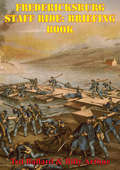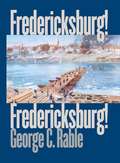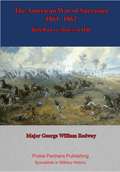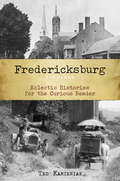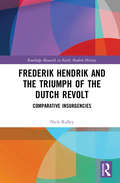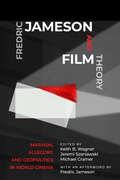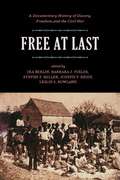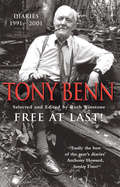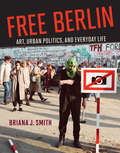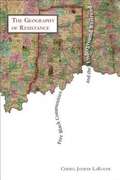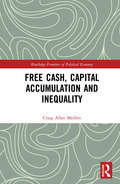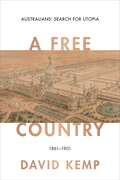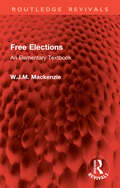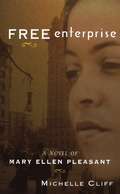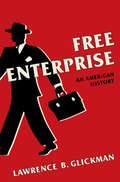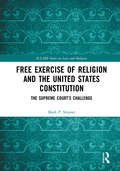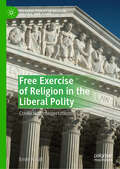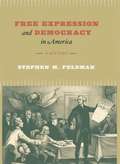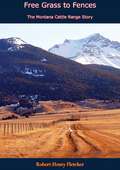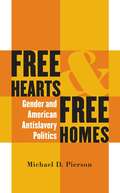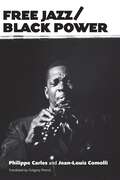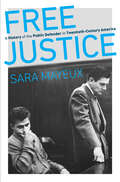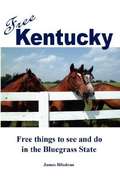- Table View
- List View
Fredericksburg Staff Ride: Briefing Book [Illustrated Edition]
by Ted Ballard Billy ArthurContains more than 20 maps, diagrams and illustrationsThe movement and details of the Union offensive plan at Fredericksburg seemed to be understood by all senior commanders; the North had a preponderance of manpower and artillery; a bridgehead was established on the enemy side of the river and initial objectives secured. Why did Burnside decide to withdraw his army back across the river to its original position? That question cannot be answered without viewing the pontoon crossing sites, the Union approach routes, the infamous "stonewall," and the other Confederate defensive positions. Accordingly, the purpose of a Fredericksburg staff ride is to visit these and other locations on the battlefield and analyze the battle through the eyes of the men who were there, both leaders and rank and file soldiers.
Fredericksburg! Fredericksburg!
by George C. RableDuring the battle of Gettysburg, as Union troops along Cemetery Ridge rebuffed Pickett's Charge, they were heard to shout, "Give them Fredericksburg!" Their cries reverberated from a clash that, although fought some six months earlier, clearly loomed large in the minds of Civil War soldiers. Fought on December 13, 1862, the battle of Fredericksburg ended in a stunning defeat for the Union. Confederate general Robert E. Lee suffered roughly 5,000 casualties but inflicted more than twice that many losses--nearly 13,000--on his opponent, General Ambrose Burnside. As news of the Union loss traveled north, it spread a wave of public despair that extended all the way to President Lincoln. In the beleaguered Confederacy, the southern victory bolstered flagging hopes, as Lee and his men began to take on an aura of invincibility. George Rable offers a gripping account of the battle of Fredericksburg and places the campaign within its broader political, social, and military context. Blending battlefield and home front history, he not only addresses questions of strategy and tactics but also explores material conditions in camp, the rhythms and disruptions of military life, and the enduring effects of the carnage on survivors--both civilian and military--on both sides.
Fredericksburg, 1862: A Study Of War [illustrated Edition] (Special Campaigns Series #3)
by Major George William RedwayThis ebook is purpose built and is proof-read and re-type set from the original to provide an outstanding experience of reflowing text for an ebook reader. Includes Civil War Map and Illustrations Pack - 224 battle plans, campaign maps, and detailed analyses of actions spanning the entire period of hostilities. Major Redway picks up his analysis of the actions in the Eastern theatre of the Civil War with his widely acclaimed book on the Fredericksburg campaign of 1862. Goaded by his political master Lincoln, Major-General Burnside assumed the offensive with the Union army in late 1862, planning to use speed and surprise to enable him to defeat the Confederate forces under Robert E. Lee. His plan started to fall apart almost immediately as he failed to move with the requisite speed and, faced with choices between vaciliation and bold action, assumed the former. What had started badly was to end disastrously for the Union forces at the Battle of Fredericksburg, as bloody frontal assaults were delivered against entrenched Confederate troops. This book is part of the Special Campaigns series produced around the turn of the 20th century by serving or recently retired British and Indian Army officers. They were intended principally for use by British officers seeking a wider knowledge of military history. Title - Fredericksburg, 1862 : A Study of War Series Name - Special Campaigns Series Series Number --3 Author -- Major George William Redway (1859-1934) Text taken, whole and complete, from the edition published in 1906, London, by Swan Sonnenschein & Co. Original - xv and 297 pages. Illustrations - The maps cannot be reproduced with this volume as they are A3 - 224 additional maps have been added.
Fredericksburg, Virginia: Eclectic Histories for the Curious Reader
by Ted KamieniakTed Kamieniak collected these fifteen superb articles to amaze and fascinate all who feel "history" is simply a well-worn path. Each selection delivers fresh perspective andintriguing events connected to Fredericksburg and Spotsylvania County, Virginia.Fastidiously investigated and painstakingly written, thiseclectic compilation presents little-visited neighborhoodsof historical inquiry. Meet Fredericksburg's first cop on thebeat; discover the persistence of hoodoo and conjurationin black plantation society; delve into the account of StateSenator Benjamin Pitts and Fredericksburg's first drive-inmovie theater--and so much more! Whether your interests lie in social history, vernacular architecture, historic technology or folkways, you will find this book an entertaining and profitable read.
Frederik Hendrik and the Triumph of the Dutch Revolt: Comparative Insurgencies
by Nick RidleyFrederik Hendrik and the Triumph of the Dutch Revolt describes a crucial period in European history. During the early seventeenth century the Dutch, led by Frederik Hendrik, were engaged in a struggle for independence from the mighty Spanish Empire. But Spain was allied with its fellow Hapsburg power, the Holy Roman Empire, and Europe was convulsed with the Thirty Years’ War. It was a turbulent time with complex diplomacy, shifting alliances, monumental battles and more European powers entering the war. Yet thanks to Frederik Hendrik’s adroit diplomacy and military skill, combined with the tenacity of the Dutch people, the Dutch Republic emerged from the conflicts and gained full independence, eventually becoming a significant European power. After tracing these developments, the book continues by examining and comparing later nationalist insurgencies in the late twentieth and twenty-first centuries. It analyses and identifies the factors making for successful insurgencies. The key factors of finances and international relations are emphasised. This volume is informative and compelling reading for both practitioners and students studying history, international relations, terrorism and insurgency.
Fredric Jameson and Film Theory: Marxism, Allegory, and Geopolitics in World Cinema
by John Mackay Dudley Andrew Jeremi Szaniawski Fredric Jameson Pansy Duncan Michael Cramer Paul Coates Dan Hassler-Forest Naoki Yamamoto Mike Wayne Keith B. Wagner Alvin K. Wong Mercedes VazquezFrederic Jameson and Film Theory is the first collection of its kind, it assesses and critically responds to Fredric Jameson’s remarkable contribution to film theory. The essays assembled explore key Jamesonian concepts—such as totality, national allegory, geopolitics, globalization, representation, and pastiche—and his historical schema of realism, modernism, and postmodernism, considering, in both cases, how these can be applied, revised, expanded and challenged within film studies. Featuring essays by leading and emerging voices in the field, the volume probes the contours and complexities of neoliberal capitalism across the globe and explores world cinema's situation within these forces by deploying and adapting Jamesonian concepts, and placing them in dialogue with other theoretical paradigms. The result is an innovative and rigorously analytical effort that offers a range of Marxist-inspired approaches towards cinemas from Asia, Latin America, Europe, and North America in the spirit of Jameson's famous rallying cry: 'always historicize!'.
Fredy Neptune: A Novel In Verse
by Les MurrayA riveting, beautiful novel in verse by Australia's greatest contemporary poet, winner of the 1996 T. S. Eliot Prize. I never learned the old top ropes, I was always in steam. Less capstan, less climbing, more re-stowing cargo. Which could be hard and slow as farming- but to say Why this is Valparaiso! Or: I'm in Singapore and know my way about takes a long time to get stale. -from Book I, "The Middle Sea" When German-Australian sailor Friedrich "Fredy" Boettcher is shanghaied aboard a German Navy battleship at the outbreak of World War I, the sight of frenzied mobs burning Armenian women to death in Turkey causes him, through moral shock, to lose his sense of touch. This mysterious disability, which he knows he must hide, is both protection and curse, as he orbits the high horror and low humor of a catastrophic age. Told in a blue-collar English that regains freshness by eschewing the mind-set of literary language, Fredy's picaresque life - as, perhaps, the only Nordic Superman ever - is deep-dyed in layers of irony and attains a mind-inverting resolution.
Free At Last: A Documentary History Of Slavery, Freedom, And The Civil War
by Ira Berlin Barbara J. Fields Steven F. Miller Joseph P. Reidy Leslie S. Rowland"Free at Last" brings together some of the most remarkable letters ever written by Americans. Made affordable and widely available for the first time, these letters, along with personal testimony, official transcripts, and other records, are drawn from the award-winning landmark reference volumes originally published by Cambridge University Press under the title "Freedom: A Documentary History of Emancipation." With great immediacy, the letters depict the drama of emancipation in the midst of the nation's bloodiest conflict, and convey the struggle of black men and women to overthrow the slave system, to aid the Union cause as laborers and soldiers, and to give meaning to their newly won freedom in a war-torn nation. The documents also show the active role of slaves and former slaves in transforming a war for the Union into a war against slavery, demonstrating, according to the "Journal of American History," "that the destruction of slavery was accomplished through black self-determination." Perhaps most importantly, the documents vividly demonstrate how emancipation transformed the lives of all Americans, black and white.
Free At Last: Diaries 1991 - 2001
by Tony BennTony Benn is the longest serving MP in the history of the Labour Party. He left Parliament in 2001, after more than half a century in the House of Commons, to devote more time to politics. This volume of his Diaries describes and comments, in a refreshing and honest way, upon the events of a momentous decade including two world wars, a change of government in Britain and the emergence of New Labour, of which he makes clear he is not a member. Tony Benn's account is a well documented, formidable and principled critique of the New Labour Project, full of drama, opinion, humour, anecdotes and sparkling pen-portraits of politicians on both sides of the political divide. But his narrative is also broader and more revealing about day-to-day political life, covering many aspects normally disregarded by historians and lobby correspondents, relating to his work in the constituency, including his advice surgeries. This volume also offers far more of an insight into Tony Benn's personal life, his thoughts about the future and his relationship with his family, especially his remarkable wife Caroline, whose illness and death overshadow these years. Tony Benn is a unique figure on the British political landscape: a true democrat, a passionate socialist and diarist without equal. With this volume, his published Diaries cover British politics for over sixty years. It is edited, as are all others, by Ruth Winstone.
Free Berlin: Art, Urban Politics, and Everyday Life
by Briana J. SmithAn alternative history of art in Berlin, detaching artistic innovation from art world narratives and connecting it instead to collective creativity and social solidarity.In pre- and post-reunification Berlin, socially engaged artists championed collective art making and creativity over individual advancement, transforming urban space and civic life in the process. During the Cold War, the city&’s state of exception invited artists on both sides of the Wall to detour from artistic tradition; post-Wall, art became a tool of resistance against the orthodoxy of economic growth. In Free Berlin, Briana Smith explores the everyday peculiarities, collective joys, and grassroots provocations of experimental artists in late Cold War Berlin and their legacy in today&’s city.These artists worked intentionally outside the art market, believing that art should be everywhere, freed from its confinement in museums and galleries. They used art as a way to imagine new forms of social and creative life. Smith introduces little-known artists including West Berlin feminist collective Black Chocolate, the artist duo paint the town red (p.t.t.r), and the Office for Unusual Events, creators of satirical urban political theater, as well as East Berlin action art and urban interventionists Erhard Monden, Kurt Buchwald, and others. Artists and artist-led urban coalitions in 1990s Berlin carried on the participatory spirit of the late Cold War, with more overt forms of protest and collaboration at the neighborhood level. The temperament lives on in twenty-first century Berlin, animating artists&’ resolve to work outside the market and citizens&’ spirited defenses of green spaces, affordable housing, and collectivist projects. With Free Berlin, Smith offers an alternative history of art in Berlin, detaching artistic innovation from art world narratives and connecting it instead to Berliners&’ historic embrace of care, solidarity, and cooperation.
Free Black Communities and the Underground Railroad: The Geography of Resistance
by Cheryl Janifer LarocheThis enlightening study employs the tools of archaeology to uncover a new historical perspective on the Underground Railroad. Unlike previous histories of the Underground Railroad, which have focused on frightened fugitive slaves and their benevolent abolitionist accomplices, Cheryl LaRoche focuses instead on free African American communities, the crucial help they provided to individuals fleeing slavery, and the terrain where those flights to freedom occurred. This study foregrounds several small, rural hamlets on the treacherous southern edge of the free North in Illinois, Indiana, and Ohio. LaRoche demonstrates how landscape features such as waterways, iron forges, and caves played a key role in the conduct and effectiveness of the Underground Railroad. Rich in oral histories, maps, memoirs, and archaeological investigations, this examination of the "geography of resistance" tells the new powerful and inspiring story of African Americans ensuring their own liberation in the midst of oppression.
Free Cash, Capital Accumulation and Inequality (Routledge Frontiers of Political Economy)
by Craig Allan MedlenInvestment is the engine of growth. In consequence, the social welfare of the populace depends on the expectations of uncertain profitability as understood by the agents of a wealthy few who decide upon levels of investment. As private wealth is intimately tied to the investment process, the importance of wealth concentration goes far beyond considerations of equity. In recent years, private economic power has become increasingly concentrated as more of the population has become dependent upon an elite pursuing private ends. In this context, this book examines the role of capital accumulation in various historical contexts. Over seventy years ago, Michal Kalecki derived the mathematical relationship between government deficits, the external trade account and free cash—defined as the gross profit over and above that portion ploughed back into new investment. Since then, the free cash literature has remained largely within an industrial organizational context where free cash theory has helped to explain mergers. In contrast, this book, revisits Kalecki’s free cash construction at the macro and global level and explores the various causes and effects of free cash on the economy. As part of this examination, the author highlights the historical uses of free cash in imperialist adventures, mergers and speculative endeavours. In addition to developing a new relative valuation measure of capital accumulation, he also utilizes a neo-Kaleckian model to help explain the U.S. slowdown in investment since the late 1960s, the increasing inequality of wealth and income and the recent speculative episodes associated with the spillage of free cash. Finally, based on these models the book argues for heightened taxes on the wealthy and an increased role for government investment in health care and energy. Free Cash, Capital Accumulation and Inequality offers an explanation as to how wealth and income inequalities have fashioned, and been fashioned by, various historical episodes right up to the present. It will be of great interest to those studying and researching in the field of economic analysis.
Free City!: The Fight for San Francisco's City College and Education for All
by Mickey Ellinger; Vicki Legion; Marcy ReinIn 2012, the accreditor sanctioned City College of San Francisco, one of the biggest and best community colleges in the country, and a year later proposed terminating its accreditation, leading to a state takeover. Free City! follows the multipronged strategies of the campaign and the diverse characters that carried them out. Teachers, students, labor unions, community groups, public officials, and concerned individuals saved a treasured public institution as San Francisco's working-class communities of color battled the gentrification that was forcing them out of the city. And they pushed back against the national "reform" agenda of corporate workforce training that drives students towards debt and sidelines lifelong learning and community service programs. Combining analysis with narrative, Free City! offers a case study in the power of positive vision and solution-oriented organizing and a reflection on what education can and should be.
Free Country: Australians' Search for Utopia 1861–1901
by David KempA Free Country: Australians' Search for Utopia 1861-1901 tells how Australians, inspired by their new democracy, attempted to use their freedom to build a society without social and economic conflict. As the second book in a landmark five-volume Australian Liberalism series, A Free Country shows the successes and missteps in the attempt to establish the legal and moral foundations for a liberal society in Australia, examining the ideological battles of the period. The national politics of twentieth-century Australia had their roots during this time, as utopian dreams of 'social reconstruction' opposed liberal ideals of individual freedom, fostering the concept of 'class wars' and leading to the ongoing involvement of trade unions in politics. As emerging collective ideas of nationalism, empire, race and class challenged individual rights and threatened to seed domestic and international conflict, liberals succeeded in bringing the six colonies into one Australian nation founded on liberal principles, writing a constitution hailed as the most democratic in the world.
Free Elections: An Elementary Textbook (Routledge Revivals)
by W.J.M. MackenzieOriginally published in 1958 at a time when many African and Asian nations were newly independent or going through the process of independence, this book sets out the facts and arguments which have to be considered in designing and running electoral systems. The book treats the problems of free elections in Africa and Asia objectively and uncontroversially, without pre-supposing any previous training in political science. The discussion of 'free elections' raises large issues about political norms and ideologies and about the working of political systems in different societies, and the book tackles these questions head on. The book gives a balanced account of the whole issue of elections, covering on the one hand qualifications and voting systems, and on the other hand less ‘political’ questions of administration and control, which are of equal importance in the working of an electoral system.
Free Enterprise: A Novel of Mary Ellen Pleasant
by Michelle CliffIn 1858, two black women meet at a restaurant and begin to plot a revolution. Mary Ellen Pleasant owns a string of hotels in San Francisco that secretly double as havens for runaway slaves. Her comrade, Annie, is a young Jamaican who has given up her life of privilege to fight for the abolitionist cause. Together they join John Brown's doomed enterprise and barely escape with their lives. With mesmerizing skill, Cliff weaves a multitude of voices into a gripping, poignant story of the struggle for liberation that began not long after the first slaves landed on America's shores.
Free Enterprise: An American History
by Lawrence B. GlickmanAn incisive look at the intellectual and cultural history of free enterprise and its influence on American politics Throughout the twentieth century, “free enterprise” has been a contested keyword in American politics, and the cornerstone of a conservative philosophy that seeks to limit government involvement into economic matters. Lawrence B. Glickman shows how the idea first gained traction in American discourse and was championed by opponents of the New Deal. Those politicians, believing free enterprise to be a fundamental American value, held it up as an antidote to a liberalism that they maintained would lead toward totalitarian statism. Tracing the use of the concept of free enterprise, Glickman shows how it has both constrained and transformed political dialogue. He presents a fascinating look into the complex history, and marketing, of an idea that forms the linchpin of the contemporary opposition to government regulation, taxation, and programs such as Medicare.
Free Exercise of Religion and the United States Constitution: The Supreme Court’s Challenge (ICLARS Series on Law and Religion)
by Mark P. StrasserThe United States is extremely diverse religiously and, not infrequently, individuals sincerely contend that they are unable to act in accord with law as a matter of conscience. The First Amendment to the United States Constitution protects the free exercise of religion and the United States Supreme Court has issued many decisions exploring the depth and breadth of those protections. This book addresses the Court’s free exercise jurisprudence, discussing what counts as religion and the protections that have been afforded to a variety of religious practices. Regrettably, the Court has not offered a principled and consistent account of which religious practices are protected or even how to decide whether a particular practice is protected, which has resulted in similar cases being treated dissimilarly. Further, the Court’s free exercise jurisprudence has been used to provide guidance in interpreting federal statutory protections, which is making matters even more chaotic. This book attempts to clarify what the Court has said in the hopes that it will contribute to the development of a more consistent and principled jurisprudence that respects the rights of the religious and the non-religious.
Free Exercise of Religion in the Liberal Polity: Conflicting Interpretations (Palgrave Studies in Religion, Politics, and Policy)
by Emily R. GillThis book addresses the challenge of providing for the free exercise of religion without allowing religious exercise by some individuals and groups to impinge upon the conscientious convictions of others. State neutrality toward religion is impossible, because neutrality means inattention to religion for some, but leveling the playing field through accommodations or exemptions for others. Both formal and substantive neutrality have a place in addressing particular conflicts. One such example is public funding for religiously affiliated social service programs, for which neither type of neutrality is satisfactory and thus some restrictions are justifiable; conversely, private voluntary organizations that do not receive direct public funding should be allowed wide latitude regarding their practices. This title also examines the expansive free exercise claims that are now made by those who argue that following the law impinges upon their beliefs, as exemplified by the ministerial exception and the Hobby Lobby and Masterpiece Cakeshop Supreme Court cases. It concludes by analyzing the relationship between neutrality and marriage as a civil status, which impacts a variety of commitment types and plural marriage.
Free Expression and Democracy in America: A History
by Stephen M. FeldmanCharting the course of free expression alongside the nation's political evolution, from the birth of the Constitution to the quagmire of the Vietnam War, Stephen M. Feldman argues that our level of freedom is determined not only by the Supreme Court, but also by cultural, social, and economic forces. Along the way, he pinpoints the struggles of excluded groups -- women, African Americans, and laborers -- to participate in democratic government as pivotal to the development of free expression.
Free Grass to Fences: The Montana Cattle Range Story
by Robert Henry FletcherThe full story of the Montana cattle industry, from the earliest days of the fur traders down to the latest Miles City Roundup, written by a man who knows the northwestern range land and its history without a map.One of the essential works on Montana Range Books by one whose family and personal work was intimately involved with the association. Robert Athearn notes it is a fine book dealing with the entire history of the West from the fur trade to the great ranches after 1885. He further observes that though it shows a conservative complaint against the New Deal and having to deal with Federal and State Bureaucrats, he nevertheless shows that the rancher on his own has genuine environmental concerns that do not coincide with mining and allied interests. The author also was famous for the song: “Don’t Fence Me In” sung by Bing Crosby.
Free Hearts and Free Homes
by Michael D. PiersonBy exploring the intersection of gender and politics in the antebellum North, Michael Pierson examines how antislavery political parties capitalized on the emerging family practices and ideologies that accompanied the market revolution.From the birth of the Liberty party in 1840 through the election of Republican Abraham Lincoln in 1860, antislavery parties celebrated the social practices of modernizing northern families. In an era of social transformations, they attacked their Democratic foes as defenders of an older, less egalitarian patriarchal world. In ways rarely before seen in American politics, Pierson says, antebellum voters could choose between parties that articulated different visions of proper family life and gender roles.By exploring the ways John and Jessie Benton Fremont and Abraham and Mary Todd Lincoln were presented to voters as prospective First Families, and by examining the writings of Harriet Beecher Stowe, Lydia Maria Child, and other antislavery women, Free Hearts and Free Homes rediscovers how crucial gender ideologies were to American politics on the eve of the Civil War.
Free Jazz/Black Power (American Made Music Series)
by Philippe Carles Jean-Louis ComolliIn 1971, French jazz critics Philippe Carles and Jean-Louis Comolli cowrote Free Jazz/Black Power, a treatise on the racial and political implications of jazz and jazz criticism. It remains a testimony to the long-ignored encounter of radical African American music and French left-wing criticism. Carles and Comolli set out to defend a genre vilified by jazz critics on both sides of the Atlantic by exposing the new sound’s ties to African American culture, history, and the political struggle that was raging in the early 1970s. The two offered a political and cultural history of Black presence in the United States to shed more light on the dubious role played by jazz criticism in racial oppression. This analysis of jazz criticism and its production is astutely self-aware. It critiques the critics, building a work of cultural studies in a time and place where the practice was virtually unknown. The authors reached radical conclusions—free jazz was a revolutionary reaction against white domination, was the musical counterpart to the Black Power movement, and was a musical style that demanded a similar political commitment. The impact of this book is difficult to overstate, as it made readers reconsider their response to African American music. In some cases, it changed the way musicians thought about and played jazz. Free Jazz/Black Power remains indispensable to the study of the relation of American free jazz to European audiences, critics, and artists. This monumental critique caught the spirit of its time and realigned that zeitgeist.
Free Justice: A History of the Public Defender in Twentieth-Century America (Justice, Power, and Politics)
by Sara MayeuxEvery day, in courtrooms around the United States, thousands of criminal defendants are represented by public defenders--lawyers provided by the government for those who cannot afford private counsel. Though often taken for granted, the modern American public defender has a surprisingly contentious history--one that offers insights not only about the "carceral state," but also about the contours and compromises of twentieth-century liberalism. First gaining appeal amidst the Progressive Era fervor for court reform, the public defender idea was swiftly quashed by elite corporate lawyers who believed the legal profession should remain independent from the state. Public defenders took hold in some localities but not yet as a nationwide standard. By the 1960s, views had shifted. Gideon v. Wainwright enshrined the right to counsel into law and the legal profession mobilized to expand the ranks of public defenders nationwide. Yet within a few years, lawyers had already diagnosed a "crisis" of underfunded, overworked defenders providing inadequate representation--a crisis that persists today. This book shows how these conditions, often attributed to recent fiscal emergencies, have deep roots, and it chronicles the intertwined histories of constitutional doctrine, big philanthropy, professional in-fighting, and Cold War culture that made public defenders ubiquitous but embattled figures in American courtrooms.
Free Kentucky: Free Things to See and Do in the Bluegrass State
by James V. BilodeauEven in this day and age of super corporations, world trade, stock market gambles, and a general preoccupation for wealth - many things are still free. Tourism today is a multi-billion dollar industry, which is growing at a rapid pace. Mega-amusement parks, roadside attractions, and adventures pop up across the countryside on a daily basis. Most of the increase in the number of attractions is for-profit ventures, but even in the booming for profit tourism industry, there are many opportunities for free entertainment. Free Kentucky will guide you to the best no cost attractions in Kentucky. Not simply a guidebook, Free Kentucky also tells the history about some of the most interesting attractions within the state.
